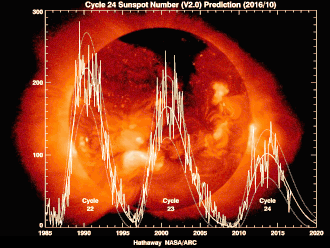
Back Sonsiklus Afrikaans دورة شمسية Arabic Günəş dövrəsi Azerbaijani Сонечная цыклічнасць Byelorussian Сонечны цыкль BE-X-OLD Слънчев цикъл Bulgarian Cicle solar Catalan Sluneční cyklus Czech Solarer Radioflussindex German Suna ciklo Esperanto


The solar cycle, also known as the solar magnetic activity cycle, sunspot cycle, or Schwabe cycle, is a nearly periodic 11-year change in the Sun's activity measured in terms of variations in the number of observed sunspots on the Sun's surface. Over the period of a solar cycle, levels of solar radiation and ejection of solar material, the number and size of sunspots, solar flares, and coronal loops all exhibit a synchronized fluctuation from a period of minimum activity to a period of a maximum activity back to a period of minimum activity.
The magnetic field of the Sun flips during each solar cycle, with the flip occurring when the solar cycle is near its maximum. After two solar cycles, the Sun's magnetic field returns to its original state, completing what is known as a Hale cycle.
This cycle has been observed for centuries by changes in the Sun's appearance and by terrestrial phenomena such as aurora but was not clearly identified until 1843. Solar activity, driven by both the solar cycle and transient aperiodic processes, governs the environment of interplanetary space by creating space weather and impacting space- and ground-based technologies as well as the Earth's atmosphere and also possibly climate fluctuations on scales of centuries and longer.
Understanding and predicting the solar cycle remains one of the grand challenges in astrophysics with major ramifications for space science and the understanding of magnetohydrodynamic phenomena elsewhere in the universe.
The current scientific consensus on climate change is that solar variations only play a marginal role in driving global climate change,[2] since the measured magnitude of recent solar variation is much smaller than the forcing due to greenhouse gases.[3]
- ^ "NASA/Marshall Solar Physics". nasa.gov. Retrieved 2015-11-17.
 This article incorporates text from this source, which is in the public domain.[dead link]
This article incorporates text from this source, which is in the public domain.[dead link]
- ^ Cite error: The named reference
haighwas invoked but never defined (see the help page). - ^ Cite error: The named reference
grida fig6-6was invoked but never defined (see the help page).
© MMXXIII Rich X Search. We shall prevail. All rights reserved. Rich X Search